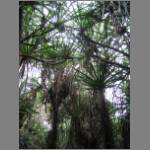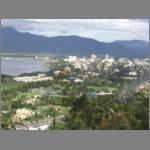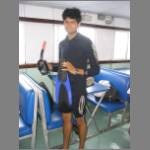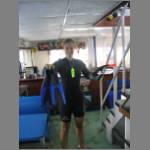



We flew from Melbourne to Cairns (pronounced without the "R", as "Canes") with the main goal of seeing the Great Barrier Reef up close. Every visitor to Australia is expected to take a look at this natural wonder (meaning, dive it or snorkel it), just like a tourist in Paris cannot avoid a visit to the Eiffel Tower. Of course, the Tower is easier to get to... Australia is a pretty big place, and flying is unavoidable if you are to see much in a short time. (Virgin Blue airline's prices are hard to beat, but don't expect them to serve you anything on the flight for free.) Cairns is a convenient point of departure for the Reef cruises, although the Reef is huge (they don't call it Great for nothing) and stretches all the way south to Rockhampton latitude. At all its points the Reef is situated at a considerable distance from the shore, about 1.5 hours by boat or longer, so you absolutely have to take an organized tour to visit it, and you better not be prone to sea-sickness.
Let's get all the questions answered right away: what is the Great Barrier Reef? Really, it's just a very large area with high concentration of coral reefs. Reefs are colonies of coral polyps, i.e. tiny marine animals that grow on top of one another to form underwater forests, or sponges, or brainlike structures, or any other shape you can think of. They shelter a great variety of other sea life forms: brightly colored fish, sea stars and cucumbers, anemones, etc. All of this stuff is animal in nature; there is plant life in the ocean (there wouldn't be any animals without it!) but it's tiny in size and hence invisible to human eye, other than as algae covering the corals. Corals, fish and everything else is very pretty to look at as you swim over it with a mask on your face. That's why people visit the Reef. If you dive, you can see even more, but we didn't and limited our Reef experience to snorkelling. It was far from disappointing, but the coral reefs themselves are not any more spectacular than the ones we had seen in Thailand; at the Great Barrier Reef there's just a lot more of them, creating an enormous coral-reef ecosystem with exceptional variety of species, which is the reason why the whole area is designated as a Marine Park and a World Heritage Site.
On top of being the gateway to the Great Barrier Reef,
the city of Cairns is also a major backpackers' center with cheap accomodations
and vibrant nightlife; on a walk around town in search
of dinner we saw such sights as a group of two dozen ladies
aged teens to nearly grandmas, all dressed up as Playboy
bunnies. Fun place to be, if you are into partying hard. Our
interests lay
more along the lines of snorkelling, bushwalking in the rainforests
and learning about aboriginal culture (see Tjapukai page), so
we got up early every day and went to bed when the nightlife
was only getting lively. Oh well, you can never have it all.
Below: Rainforest boardwalk and Mt Whitfield Conservation Park near Cairns. Get that: just a 10-minute drive from the downtown shopping mall, and you find yourself in a dripping-wet, sunlight-blocking, lush-green, honest-to-god rainforest! Not a very expansive one, granted, but large enough to sustain the illusion and give you a nice workout on the trails. Mt Whitfield park even has a sizeable population of cassowaries, Australia's other large flightless birds (other than emu, that is). We didn't meet this "Lord of the rainforest", only some brush turkeys -- or were they scrub hens? Anyway, nice walk.
And now to The Big
Deal: our snorkelling trip
to the Great Barrier Reef. Not
surprisingly, there aren't any
pictures of the astounding life
forms of the Reef-- corals, fish,
anemones and other colorful
marine creatures that look like
products of an overexcited imagination.
That's because we don't have
an underwater camera, and photography
through the floor windows of
a glass-bottom boat does not
work (I tried). So you don't
get to marvel at pics of sea
turtles, only of the Mehras
in wetsuits (keeps you warm,
helps flotation and protects
from stings).


Above: getting dressed for snorkelling.
Below: Boomnetting!
What's that, you say? Ahh... It's the Aussie way of having additional fun when going out on a snorkelling/diving trip with a big boat. They attach a wide-mesh fishing net to the back of the boat ("netting" part explained), get a bunch of people to lie on the net holding on to the ropes, and start the boat's engine (that's where the "boom" comes into play). The adventurous souls get dragged behind the boat at a fairly fast speed (at least it feels that way), losing first their swimwear items, and then their grip on the net, but gaining a lot of saltwater in the face and an awesome experience to write home about. Needless to say, we had to try it out on our first boat trip, but politely declined the next time around :-)